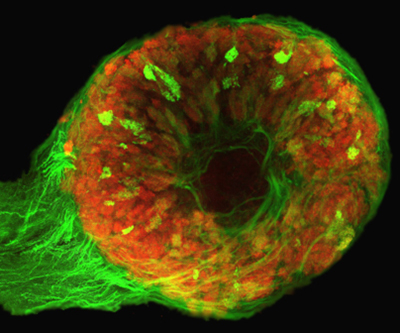
Microscopy image of the locust antennal lobe, a brain area that processes information about odors. Olfactory receptor neurons send fibers (green) from the antenna (left) into the antennal lobe, where they form spherical structures called glomeruli (red). Here, the fibers transfer olfactory information to follower neurons for further processing. The human olfactory bulb is organized similarly.
Credit: Stopfer Lab, NICHD
The brain is an extraordinary and complex organ responsible for gathering, organizing, and processing sensory information from the environment. To understand the intricacies of brain function, many scientists employ simple model systems, like the sense of smell in insects, as valuable tools for investigation.
The Stopfer Lab at NICHD uses olfaction (the sense of smell) as a model for understanding basic properties of neural circuits. In insects, as in people, odorants bind to olfactory receptor neurons, triggering bursts of activity comprised of pulsed electrical signals called action potentials. These signals travel into the brain where they trigger responses in many types of follower neurons, allowing the brain to create a description of the olfactory environment.
In a recent study, the lab examined in detail how olfactory receptor neurons on the antennae of locusts respond to odors. The team found that these neurons can generate four different types of firing patterns, or motifs, when exposed to different odors. They also found that a single olfactory receptor neuron can respond to different odors with different firing motifs, a new property called “motif switching.” These patterns can also change over time when the same odor is repeatedly presented to the receptor neurons. In this way, the patterns can provide information about the recent history of exposure to the odor.
Working with collaborators in Dr. Maxim Bazhenov’s laboratory at the University of California, San Diego, the team used computer modeling to understand how these firing patterns help olfactory neurons process odors under natural conditions, such as when moving air stretches and swirls odor clouds into complex plumes. The computational analysis showed that combinations of firing motifs from groups of olfactory neurons together help the animal classify odors and extract important information about the environment, such as the distance to the odor’s source.
Overall, the lab’s studies show that olfactory neurons use the timing of the different response motifs to create a more complex and accurate representation of odors, an ability essential for animals to thrive in their environment, and for the well-being of people.
Learn more about the Neurosciences Affinity Group:
https://www.nichd.nih.gov/about/org/dir/affinity-groups/neurosciences
 BACK TO TOP
BACK TO TOP